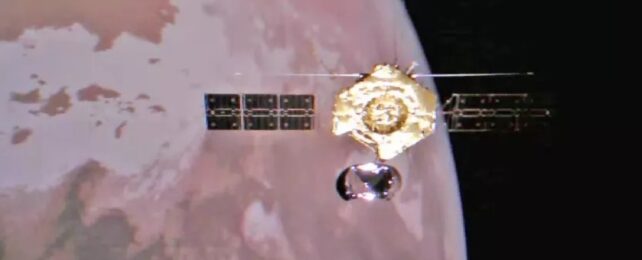China continues to take great strides as part of its goal to become a superpower in space and a direct competitor with NASA.
In addition to its proposed expansion of the Tiangong space station and the creation of the International Lunar Research Station (ILRS), China is also planning on sending crewed missions to Mars in the coming decade.
In preparation for the arrival of taikonauts on the Red Planet, China is gearing up to return samples of Martian soil and rock to Earth roughly two years ahead of the proposed NASA-ESA Mars Sample Return (MSR).
This mission will be the third in the China National Space Administration's (CNSA) Tianwen program (Tianwen-3) and will consist of a pair of launches in 2028 that will return samples to Earth in July 2031.
According to a new study recently published in the journal Chinese Science Bulletin, Chinese scientists announced that they have developed a new numerical model to simulate the atmospheric environment of Mars. Known as the Global Open Planetary atmospheric model for Mars (aka. GoPlanet-Mars, or GoMars), this model offers research support in preparation for the Tianwen-3 mission.
The paper, titled "Development of a new generation of Mars atmosphere model GoPlanet-Mars," was performed by researchers from the Institute of Atmospheric Physics Chinese Academy of Sciences (IAP-CAS), the State Key Laboratory of Numerical Simulation of Atmospheric Science and Geohydrodynamics (LASG), and the School of Earth and Planetary Sciences at the University of Chinese Academy of Sciences (SEPS-UCAS).
The study was led by Wang Bin, a Senior Researcher with the CAS-IAP who specializes in climate modeling.
In the past two decades, the number of missions and space agencies engaged in the exploration of Mars has increased considerably.
At present, ten robotic missions are exploring its surface and atmosphere, including seven orbiters, two rovers, and one helicopter. And with many more destined for Mars in the next decade (as well as crewed missions), the demand for Martian weather forecasts is growing.
As they indicate in their paper, "The world's aerospace powers have developed Mars atmosphere models to provide meteorological environment protection for landing exploration."
To provide information on the meteorological conditions around the Tianwen-3 mission's potential landing sites, the research team built a global open planetary atmospheric model for Mars. They then used this model to replicate the three critical cycles of the Martian atmosphere: dust, water, and carbon dioxide.
They then tested the model using the Open access to Mars Assimilated Remote Soundings (OpenMARS) dataset, a global record of Martian weather from 1999 to 2015, as well as observations made by China's Zhurong rover (part of China's Tianwen-1 mission) and NASA's Viking 1 and 2 landers.
Their results showed that the GoMars model successfully reproduced the unique characteristics of surface pressure on Mars and provided good simulation performance for the surface temperature, zonal wind, polar ice, and dust.
According to Wang, the Tianwen-3 mission will expand upon Tianwen-1 by adding the additional tasks of landing, sampling, and returning, which requires detailed information about Mars' atmospheric conditions. This is crucial given how sandstorms caused multiple missions to be lost, such as Opportunity, Insight, and Zhurong – all due to the buildup of dust on their solar panels.
In addition, the Perseverance rover suffered damage to one of its wind sensors during a sandstorm due to airborne pebbles colliding with it. Since observation data is in short supply for Mars, the model also has applications for virtual reality simulations.
This is necessary when prepping missions to remote planets, which helps them design vehicles and select appropriate landing sites. In this respect, a "virtual Mars" program that incorporates GoMars and future observations could take a lot of the guesswork out of future mission planning.
Since the 1960s, when the Soviet and American space programs began sending probes to Mars, scientists have been developing Martian atmospheric models in the hopes of overcoming the "Mars Curse." With a growing number of nations sending missions to Mars, the need for climate modeling has become all the more crucial.
In the end, dust and weather can have a significant impact on the entry, descent, and landing (EDL) phase. They can also affect surface operations, particularly where solar panels, communications, and sensitive instruments are concerned.
They can also be a problem during the ascent phase, where missions attempt to reach orbit and return to Earth – for example, as part of a sample return mission. As Wang commented in an interview with the Xinhua News Agency:
"The dust cycle on Mars is as important as the water cycle on Earth. GoMars can be used to simulate the dust activity before and after the rover's dormancy, which can provide atmospheric environment data to analyze the possible causes of the dormancy.
For example, GoMars can simulate the temperatures of the landing zone, and scientists can use these data to design materials that are suitable for building Mars rovers to cope with extreme cold."
Early in the next decade, NASA and the ESA also intend to send the Mars Sample Return (MSR) mission to retrieve samples obtained by the Perseverance rover. This will consist of a NASA Sample Retrieval Lander, two Sample Recovery Helicopters, a Mars Ascent Vehicle, and an ESA Earth Return Orbiter.
NASA and the ESA currently expect this mission to launch no sooner than 2033, coinciding with NASA's first crewed mission to Mars leaving Earth. Clearly, the new Space Race extends beyond the Moon and now includes reaching Mars!
This article was originally published by Universe Today. Read the original article.
